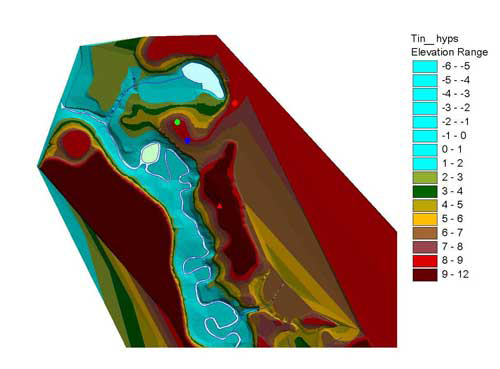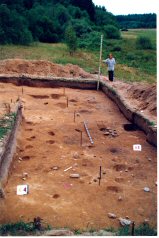
Figure 4: Serteya Valley, northern part (GIS 3-D projection)
This unit consists of several sites located in the northern part of the valley (Fig. 4). The Mesolithic sites are exclusively lithic-based. Early Neolithic sites are distinguished by the occurrence of early varieties of pottery wares.

Figure 4: Serteya Valley, northern part (GIS 3-D projection)
Stone tool assemblages at several sites located on elevated levels (Serteya 3-1, 10, 14 and 19) show affinities with the Early Mesolithic Kunda Culture in Eastern Latvia, as exemplified by the 'Pulli-type' arrowheads, points and borers on sub-triangular flakes, sub-triangular axe-like tools, scrapers on flakes and (more rarely) blades, inserted blades and micro-blades (Fig. 5)

Figure 5: Serteya 14. Mesolithic artefact
The sites Serteya 10, 14, 6, 7, 3-1, 3-2, 4, 5, 6, 9, 10, 11 include artefacts attributable to Late Mesolithic. Two sites (Serteya 10 and 14) are considered as camp-sites; they included remains of circular dwelling structures with post-holes along the perimeter and the axis. Several circular hearths were identified inside the dwelling located in its middle part and along the wall facing the water channel (Fig. 6). Lithic industries included prismatic tanged arrow-heads, conic and unipolar cores, sub-triangular axe-like tools, blades and retouched blades. Their analogies are found in the later varieties of the Kunda Culture and the Dniepr-Dvina Mesolithic in Byelorussia.

Figure 6: Serteya 14. Dwelling structure

Figure 7: Serteyan pottery (Rudnya-Serteya site, Layer A)
The oldest pottery-bearing culture is refered to as Serteyan. Its early stage was identified at the sites Serteya 10 and Rudnya-Serteya, Layer A. The conic pottery vessels were made of clay tempered with coarse sand and organic matter, and ornamented by rows of triangular impressions (Fig. 7). The stone industry consisted of fragmented implements made on blades and flakes. Cores are both prismatic and unipolar. The complete tools included circular scrapers, sub-triangular axe-like tools and bifacially retouched arrow-heads. Rare bone implements include tanged points, borers and pendants (perforated elk incisors). Remains of a rectangular dwelling structure with a submerged floor were identified in Layer A of the Rudnya-Serteya site. Two radiocarbon dates have been obtained for wood fragments from the Serteya 10 site, 7300±400 and 7350±180 (uncal. BP), or the mean value of 6225±300 cal. BC.
The 'second pottery stage' includes the sites belonging to the later variety of the same Serteyan cultural tradition. These sites are found both on the elevated mineral shores (Serteya 3-2, 3-3, 12, 13I, and 20) and also on the lower shore levels and islets (Serteya, 14, 17, 19, 21, 8, 'Field' above the Rudnya-Serteya 1, and Zabolonye 1). They include both conic and flat-bottomed pottery wares with slightly different ornamental patterns. Rectangular post-framed dwelling structures were identified at the larger sites, Serteya 10 and 14.
The sites belonging to the 'third pottery stage' (Serteya 12-14, 16-19, 21) are found on the palaeolake's higher levels. The largest site, Serteya 14, includes the remains of three sub-rectangular post-framed dwelling structures, with the rows of posts both along the walls and the middle axis, and with stone-laid hearths. At this stage, the lithic industry became less diverse. The pottery remains unchanged, with less than 10% of ornamented potsherds.
The later culture became known as Rudnyaian. This culture is exemplified by Layer B at Rudnya-Serteya, Serteya 10 and 14. All these sites are found on the lower levels and obviously correspond to a considerable fall of the lake-level. Its pottery was made of clay tempered with crushed shells, organic matter and sand. Stylistically, it forms a direct continuation of the Serteyan tradition with the addition of rounded bottom, S-profiled vessels. The ornament is restricted to the upper part of the vessels and consists of thin comb and impressions. A rich bone and antler industry includes unilateral points, biconic awl-like points, spatulas, tanged points with spikes, points and chisels from broken tubular points, and analogies with several early Neolithic sites in the eastern Baltic area. Lithics consist of oval-shaped small polished axes, rhomboid arrowheads, bipolar and unipolar prismatic cores. Several radiocarbon dates are available: 6240±60 (LE-3054), 6230±40 (LE-2568), 6180±70 (LE-2569), 6130±40 (LE-2579) BP uncal. (all within the range of 5340-4930 cal. BC).
A slightly different pottery style has been recognised in an elevated area of the Rudnya-Serteya site; it included 'mitre-shaped' vessels with straight and rounded rims, decorated by horizontal or diagonal rows of dots, incised lines or comb impressions. This pottery combines the Rudnyanian style and that characteristic of Narvian sites in the eastern Baltic area, as well as the Upper Volga and Upper Dniper cultures. Several radiocarbon dates were obtained for this level: 5940±60 (LE-2566), 5940±45 (LE-4101) and 5850±70 (LE-4100) BP uncal. (all within the range of 4960-4540 cal. BC).
A fish weir was found directly above this level at the site of Rudnya Serteya. Its radiocarbon dates form a coeval sample with a mean value of 5513±95 uncal. BP or 4439±72 cal. BC.
© Internet Archaeology/Author(s)
University of York legal statements | Terms and Conditions
| File last updated: Wed Dec 15 2004